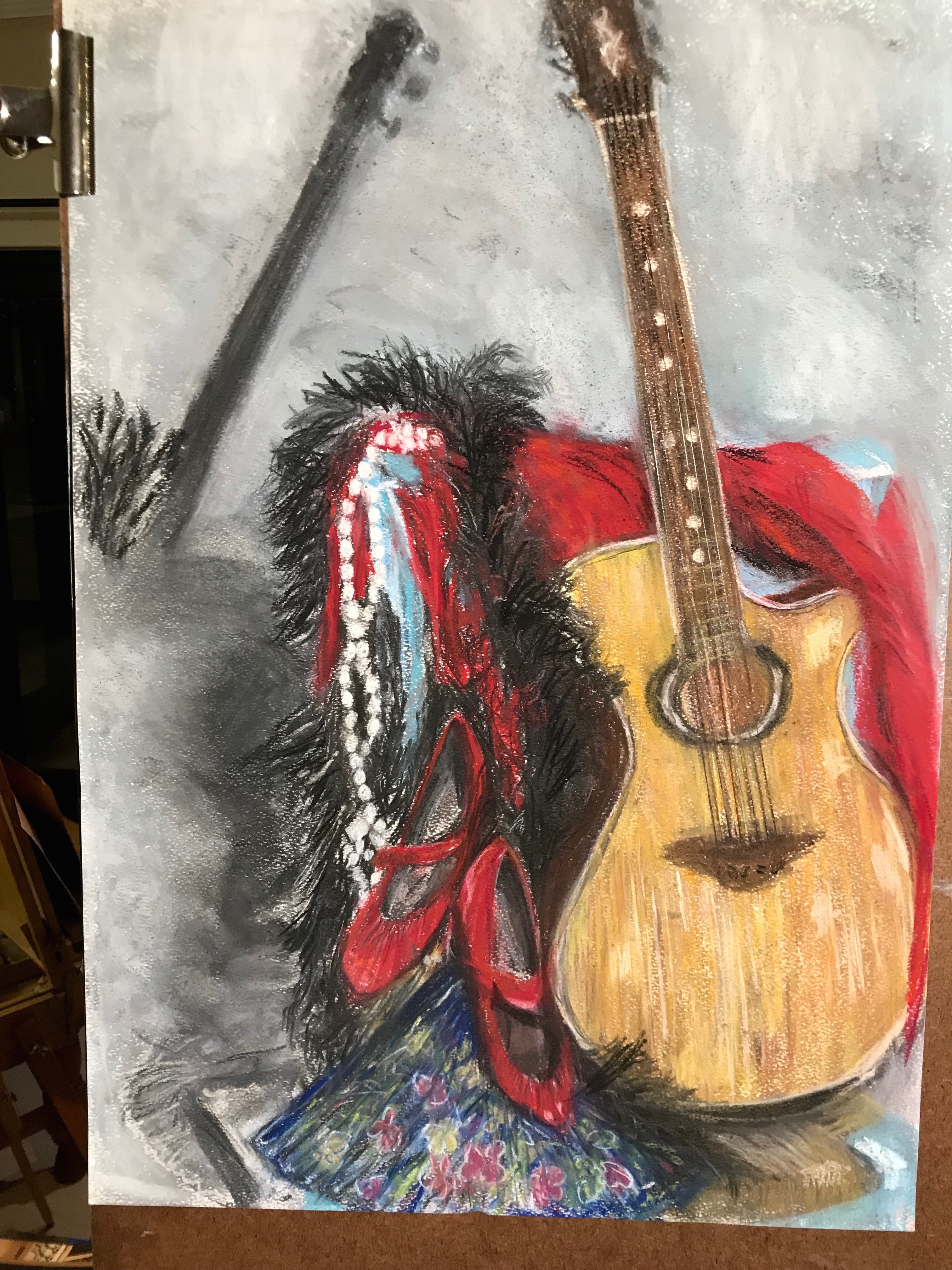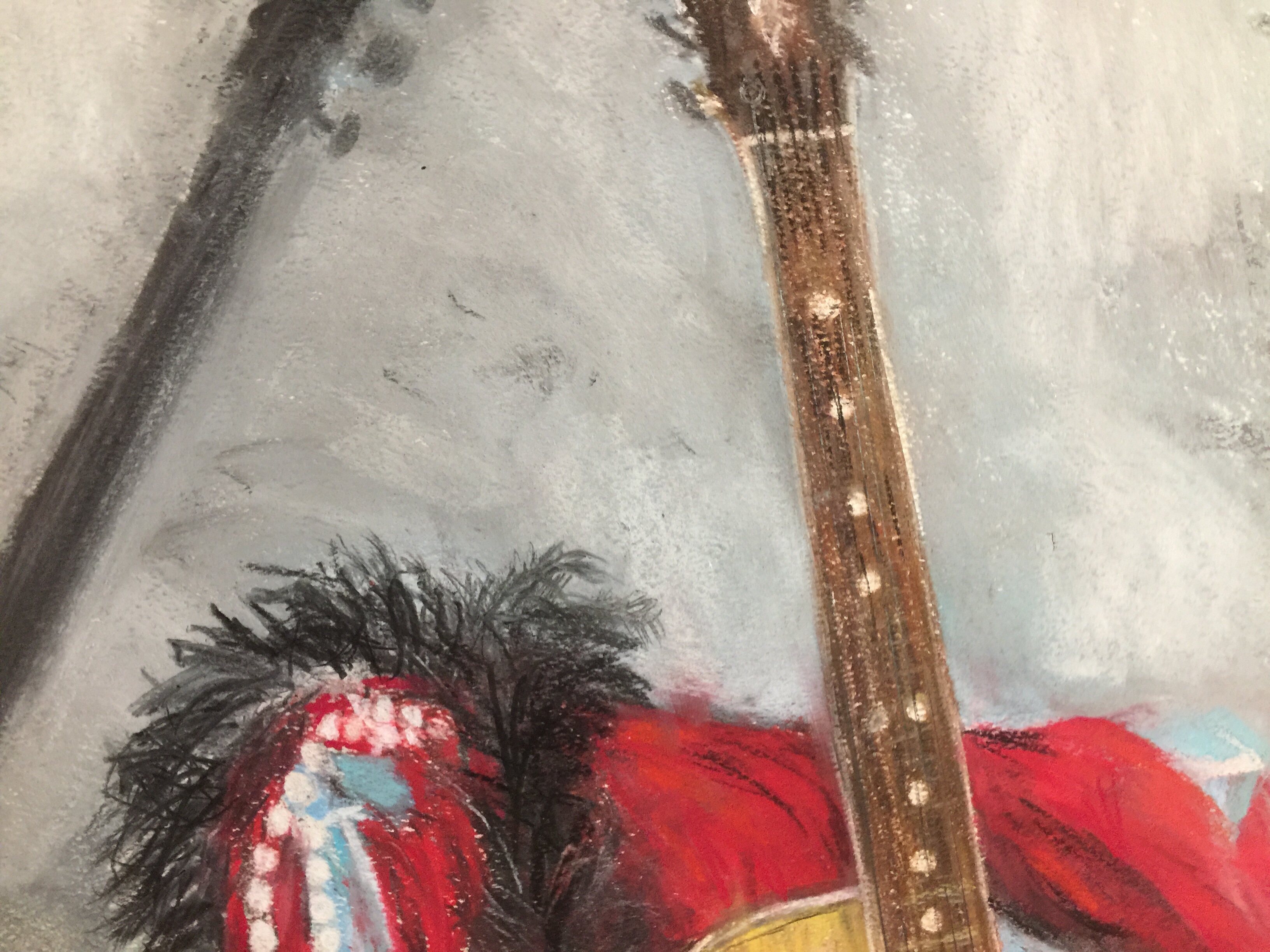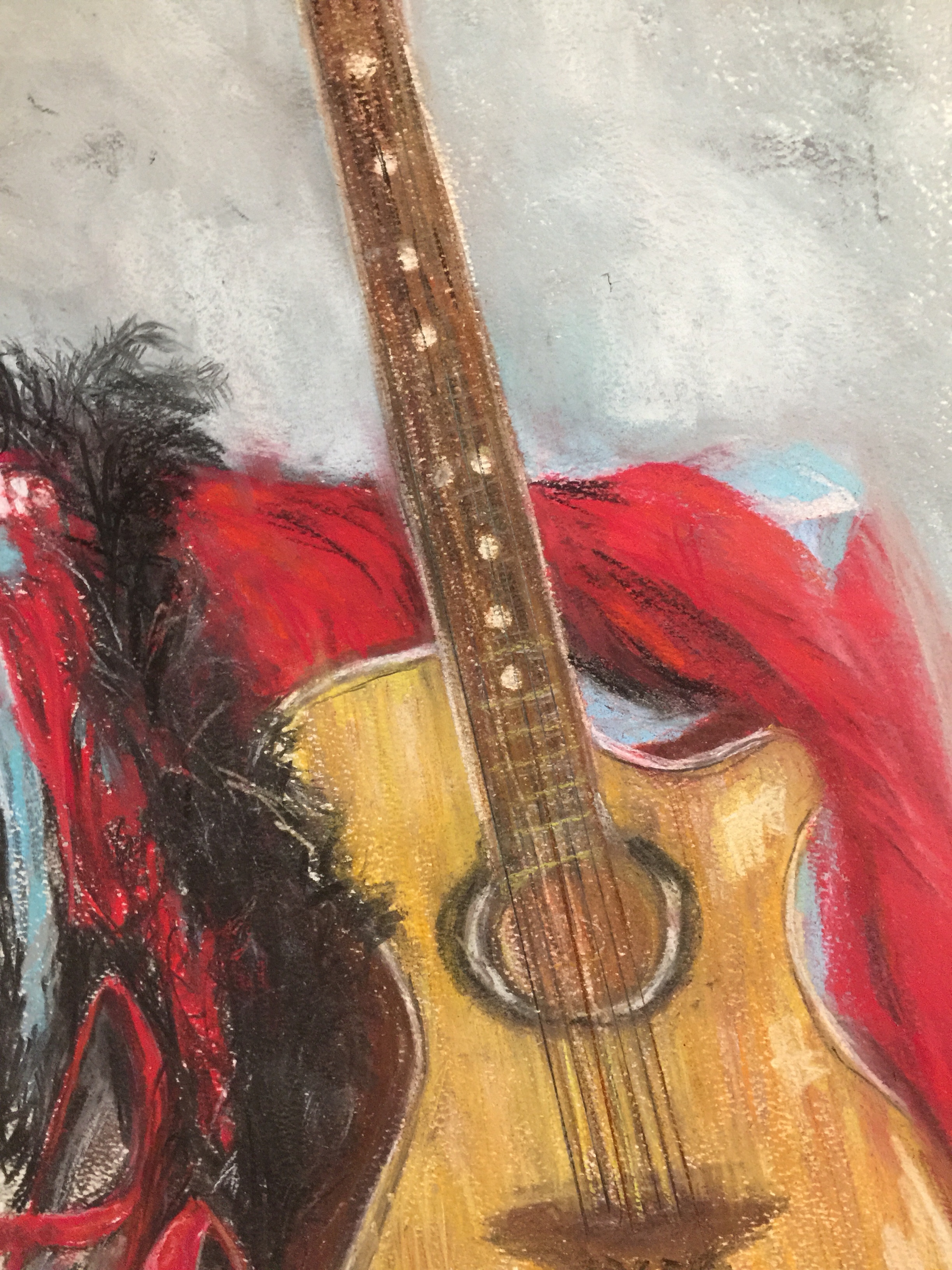27 May 2018
The idea is to pull together the fine observation and the practice I have done during this part of the course up to now.
I have been listening to Flamenco and Fado music recently and decide to bring my memory of the Singer Sargeant El Jaleo painting, into this exercise. Although I have never stood in person before this painting, I have always admired the scene created and my impressions from what I have read and see in it, is something of a rawness of emotion , sensuality, as well a great rhythm. ” It is a very big canvass that shows snapshot of a specific point in time: the apex of the dance, a moment filled with energy and sensual drama. The footlights cast haunting silhouettes on the rear wall; the raw passion of the dance is palpable. “The stark contrasts between murky shadow and dazzling illumination allow the painting to visually pop.” (taken from the website of the Isabella Stewart Gardner Museum, Boston) My Still Life attempt is a quiet moment, but I like to see it happening somewhere behind the stage of El Jaleo – maybe a dancer who went outside for fresh air…?

I decide on a mixed media white paper, size A2, and work with charcoal for outline and drawing strong lines of subject and then work with soft pastels to create form. After a quick poster study, I am pleased with the chair I have chosen to put my subjects on. I change the black dress for a red draping that hangs over the chair to have the contrast of the hard surface of the chair into the drawing as well as to add drama. I will however not use much white and or cream-white in my composition and hope the red adds to the emotion to be attempted in this drawing. There are a few textures to consider, leather, guitar wood, feathers, shiny fabric and the pearls. I love the shadow the guitar creates in my composition: it reminds me of the lovely moody shadows in Sargeant’s painting. I read more about El Jaleo, and the following is just to great not to share.Source: Trevor Fairbrother, “El Jaleo,” in Eye of the Beholder, edited by Alan Chong et al. (Boston:ISGM and Beacon Press, 2003): 159. “During his travels in Spain in 1879, Sargent was mulling over a major work of art in which he could express his love of Gypsy music, dance, and picturesque costumes. On his return to Paris he set to work on a wide horizontal picture whose proportions simulated the shallow stage space of popular musical establishments. He named the painting El Jaleo to suggest the name of a dance, the jaleo de jerez, while counting on the broader meaning jaleo, which means ruckus or hubbub. The painting was exhibited at the Paris Salon of 1882 with the more explicit title El Jaleo: Danse des gitanes (Dance of the Gypsies).”
I enjoy drawing with the combination of soft pastels and charcoal – and spend some time to create the almost uneven texture of the background wall (mine is two big canvasses set up behind the chair). I am thinking of quick lines and sharp marks to use in the feather boa as well as the shadow marks on the floor and back wall. I revisited my lines in Angst (exercise 1 of Part One) , as my tutor suggested, and the work of Egon Schiele, to bring emotion into my drawing style. I have come to the understanding that my first opinion, glance (ignorance?) and understanding of Still Life was a type of falseness, fake creation, pretentiousness… and genre I did not want to put my hand on; now I understand to bring life into it is what composition of a Still life is about. I understand the second part of this course as being called Intimacy — what a great discovery during this very enlightening process of learning, reading and doing exercises and stretching myself. It would have been wiser to even use a bigger size paper for this composition. As I progress I see more attention is needed on the reflected light on the guitar as well as shoes and the feathers, and use a spotlight shining onto the guitar from a higher position. I do like the shadows in the shoes and hope to show this well in the drawing.

It is a moment – life is ongoing. It is a process – Still life. A moment taken out of life.I enjoy drawing on a bigger scale, my hand and arm move much easier around. I also feel the drawing is loose and allow for excitement.
I found the following on the Tate website: “Although in a general sense any piece of music or writing, painting or sculpture, can be referred to as a composition, the term usually refers to the arrangement of elements within a work of art. An artist arranges the different elements of an artwork so as to bring them into a relationship satisfactory to them and, it is hoped, the viewer. In the classical tradition, triangular or pyramidal compositions were used because they created a sense of balance and harmony by arranging the figures into a stable overall geometric structure. The idea of composition as the adjustment of the relationships of the elements of the work within the border of the canvas, remained unchallenged through the upheavals of the early modern movements such as cubism and abstract art.”
REFLECTION ON ASSIGNMENT 2
I tried to apply my technical skills as well as observational skills with the final drawing. The different textures was a challenge and I think the feather boa was hard to represent – my short and fast marks is not that convincing to the likeness of the soft black feathers. I love the colour pallet and think the drawing should have been on an even bigger scale. I asked myself during the drawing process why I chose the objects as I did – I believe I wanted to create a scene which is not set on a table with normal household items. I liked the challenge that some form of intimacy being brought into this drawing. I wanted to explore the need to show a composition of a moment of my thoughts focused on Nature Morte. Hopefully a gaze which explores the visual beauty of a “staged” composition, while at the same time searching for moments within, and knowing that things will end.
I discovered a book on Nicola Samori’s Instagram entitled “What painting is” by James Elkins. The book focusses on the alchemy of painting.. Here is a quote:
“PAINTING is alchemy. Its materials are worked without knowledge of their properties, by blind experiment, by the feel of the paint. A painter knows what to do by the tug of the brush as it pulls through a mixture of oils, and by the look of coloured slurries on the palette. Drawing is a matter of touch: the pressure of the charcoal on the slightly yielding paper, the sticky slip of the oil crayon between the fingers. Artists become expert in distinguishing between degrees of gloss and wetness—and they do so without knowing how they do it, or how chemicals create their effects.”
TUTOR FEEDBACK ON ASSIGNMENT 2
11 June 2018
I had a Google Hangout session of 30 minutes with my tutor to discuss my second assignment. He accessed my work though my blog and followed the session up with a short written feedback.
In terms of practicality due to my move to Dubai by end July, we discussed that I start ahead with some parts of the next project, as I am not sure if opportunities for life drawing will present itself easily in Dubai. I do plan to have opportunity to work at an Art Hub.
My tutor is happy with the body of work I presented as well as the quality of visual language. He refers to some exercises as being fresh in its approach. We discuss some of my attempts. The drawing of the seal skull is experimental and the use of scraping back into the lines is appreciated. I am happy the line works of the grass circles was a good subject matter. it is something I would consider to take further in other drawings – like add the trees in the garden. It is great that my photo of my yellow still life with the lemon is appreciated – as I do not see myself as a very good photographer. I am motivated to explore the use of creative constraints further in my work, this is something I believe is important to grow. I very much appreciated the way in which my tutor highlighted the qualities within the exercises as well as areas for development. It feels important that I take this to heart and practically show this in my next assignment work. I am encouraged to experiment as well as reflect on the work of other artists. I can see the benefit of this for my own development and learning. I value that he sees some work as ‘sensitive drawings, particularly your line work” and my use of varied mixed media. I need to start thinking of the assessment at the end of this course, hopefully by end of March 2019.
Keep working at experiments with range of media as well as approach – this will keep my approach fresh and help towards being more experimental and pushing myself with regards to my assignments, which is still too restrained. I need to look at combining materials, media, colour and techniques. Would like to see this developing in the rest of the course as well as come to something in my final assignment -where I see I will actually have an open choice in terms of subject and theme. I find I feel more comfortable with organic materials and being outside. I also love to push the technique of Chiaroscuro further and bring my rhino studies into play. I am however aware that our move to the UAE might change this opportunity. I would think I should look at work of artist in the Islamic art world and work with sensitivity to the change of environment.
A challenge is to
- ‘explore ‘the ‘use of creative constraints further‘
- ‘keep varying scale, materials and duration throughout your process – allowing you to select from any part of your process for assessment.’ This is important for assessment – I looked ahead an see that the final assignment is a ‘personal project – where combining and experimenting will be very much the end product
- make ‘several studies of one subject with deliberately different approaches’.
I need to make sure what is the creative constraints within this part of the course – making more studies and experimenting during these drawing studies would surely help. Look at sensitive composition and creative use of materials:
- use of colour in drawing
- most appropriate medium for the subject
- composition and context – grouping of objects, texture and light
- mark-making and contrasts of line and tone
- accurate and expressive depiction of form
- experimentation with idea, material and method
- continuously asking ‘Am I using the most appropriate medium, colour, method, etc.?
- Experiment in sketchbook, make notes
- spend time gradually building the drawing,,, need to show skills learned and knowledge gained in part two.
Assignment 2
My tutor commented that the choice of composition is well considered. He would however still like to see less restrained experimentation – with materials, media, colour and techniques. This will add to a more ‘lively’ piece of work. I can see that I got very much bogged down in details of the composition, rather than the possibilities of what ‘lay inside of the composition’. I look back on my thoughts during this drawing and my tutors suggestion to feel free to ‘jump ahead and borrow from part 4 tasks’ I realise a great opportunity of exploring with this work with regards to part 4 and the final part of this course. I plan to explore this drawing more – work on more studies. I re-think the ideas of Part Two: Intimacy and that it mainly focussed on close observation and interpretation, the use of colour and media – this then sits with me for a while: “the broad subject is your own environment and the range of textures, shapes, tone and line to be found within it. I need to show experimentation with different scale, mark making techniques and duration in my drawing process. Make several studies of one subject with deliberately different approaches. This is a great area for development, especially if I add constraints of colour and push the use of tone and line.
Looking back, I find my approach to the assignment was more about the composition than bringing in the learning – light could be more sensitive – thinking about the grass circles and the line work, using hatching on the rock. I see that I have made a distinction between the exercises and presenting an assignment. I feel stronger in my understanding that I could have explored and experimented more. I plan to add more experimental studies to my assignment 2 – thinking of changing or re working it.



